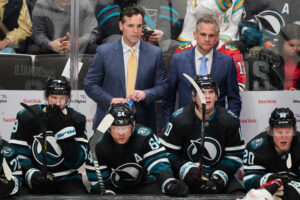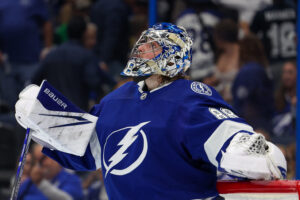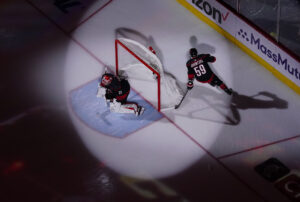Fans have demanded for changes in the Vancouver Canucks defence for a few years now. One of the major criticisms during the 2018 off-season was that there were zero changes to a clearly inadequate defence. A squad that managed just 21 goals with 264 scored against them was considered good enough for the next year. This clearly needed to change.
A Revamped Vancouver Canucks Defence
Wholesale Changes Needed
For perspective, it’s not like they were all that effective before. They were simply hoping to recapture past glories. In the 2017 off-season, they lost Luca Sbisa to the expansion draft and Nikita Tryamkin returned to Russia. Those were the only changes in a Vancouver Canucks defence that managed a mere 22 goals of a team-history low 178. The year before that the blue line had a combined 23 goals. Before that season they scored 34 goals, led by Yannick Weber of all people.
You have to go back to the league-leading offence of 2010-2011 before the defence even breaks 40 goals. It’s been a while.
Wholesale Changes Managed
That finally changed in a dramatic way this year. Not only did half their starting six change, but even eternally reliable seventh defenceman Alex Biega was moved when he couldn’t crack the lineup. Offensively talented rookie Quinn Hughes has picked up where he left off last year, getting three points in five games. Tyler Myers has been moving the puck effectively, helping his partner Alexander Edler get off to a roaring start. Jordie Benn has helped his third-pair partner Troy Stecher take a hand in the team’s offence.
That third pairing says it all about how the new arrivals transformed the team beyond elevated scoring.
Pairing Up
The pairs were pretty much set since the pre-season: Myers-Edler, Chris Tanev-Hughes, and Benn-Stecher. The biggest difference between this season and last is how the new arrivals have changed the game for the veterans.
Myers-Edler
The elder statesman of the Canucks blue line, Edler hasn’t averaged less than 22:30 minutes a night in a decade. Partially, as a result, he hasn’t played a full season since 2011-2012. A partner who can skate as well as Myers does has provided him with an option to carry the puck himself. Given he is the Canucks’ best defenceman, they want to reduce the number of hits and blocked shots he takes. He blocked nearly three shots a game in the last two seasons, and that takes a toll on your body.
Ideally, the 33-year old will be able to cut down some of his ice time this year, as well. The hardest part of the coaches’ job is getting him off the ice without an injury. In theory, Hughes will eventually take some of his power-play time, but not until Edler lets him. With three power-play points and five points in five games, he’ll be hard to move.
Hughes-Tanev
A bit of a cheat to call Hughes a new arrival, but he qualifies as a rookie so close enough. His five-game sample from last year showed what he could do with three assists in five games. Coach Travis Green wanted to protect him, but Hughes forced his hand, ending with 20 minutes of average ice time.
More than that is how well Hughes’ skating protects Tanev. Tanev’s game is all about skating out of trouble and moving the puck quickly, which doesn’t always work. Teams are aware of the danger Hughes poses, and treat Tanev as the lesser threat. In the previous three years, he has been hit regularly in his own end while retrieving the puck. Tanev is not a physical player and takes far more hits than he’ll ever throw. Taking more than two hits per game has been very detrimental to his health. Unfortunately, they’ve been tough to avoid with him playing a defensive role.
Paired with Hughes, Tanev is starting off on the attack far more than at any other point in his career. The less often he takes the puck while looking over his shoulder, the better. He’s never managed more than 70 games in a season, and this year he can hit a new career-high.
Benn-Stecher
The Vancouver Canucks defence changes have gone all the way through the team, right down to the third pair. Benn adds a physical element that had been missing since Erik Gudbranson was traded away for Tanner Pearson. He’s got a limited scoring ability but still managed 22 points with the Montreal Canadiens last year. He’s well placed on the third pair with Stecher.
Stecher, on the other hand, has never played so few minutes as this year. While his time is reduced, it’s the natural result of an improved team rather than a demotion. Stecher and Benn are relied on to be solid defensively, but both have a bit of scoring touch if needed. Stecher has taken advantage of matching against weaker opponents to get two points already this year. Knowing he can also rely on his partner to cover the defence has let him attack more frequently.
Way Too Early Conclusion on Vancouver Canucks Defence
The Vancouver Canucks defence changes have led to the defence getting six goals in five games. Them scoring a third of the team’s goals is unsustainable. However, the play has still moved out of their own end. This makes the defenders themselves less vulnerable to big hits and eases pressure on them and on the goaltenders.
Getting more scoring is great, keeping the team relatively healthy is a nice bonus. Last year, just one defenceman played more than 70 games. It’s difficult to gel as a team with a turnover that high. This season more offence can lead to less physical play, which will keep the team healthier. The hope is that will lead to greater familiarity, which can get them more scoring.
The Sedins may not be in town anymore, but the cycle is still an important part of the team.
Main Photo:






